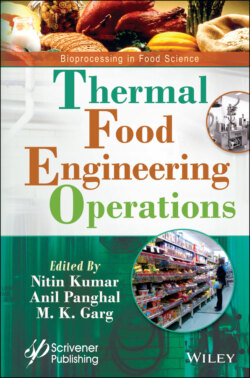Читать книгу Thermal Food Engineering Operations - NITIN KUMAR - Страница 48
2.6.2 Microwave Heating 2.6.2.1 Principle and Mechanism
ОглавлениеWith the advancement of emerging technologies, microwave energy has paved its way and has become an indispensable part of every household system. The use of microwave has expanded from heating and defrosting to thawing, blanching, sterilization, drying, etc., in food industries [55, 56]. Microwave is electromagnetic waves with a frequency which ranges from 300 Mhz to 300 GHz. Frequency of microwave used for domestic purposes is 2.45 GHz, whereas the frequency for industrial one is 915 MHz [57]. In the microwave system, the two oscillating perpendicular fields, i.e., electric and magnetic, act directly on the heating material, converting the part of absorbed energy to thermal energy. The interaction of the microwave radiation with chemically bound water present in the food material generates high pressure and temperature due to the absorption of the characteristic photonic energy of electromagnetic waves. This process causes moisture evaporation resulting in pressure exertion on the plant material to cellular and subcellular level leading to swell up and rupture eventually [58]. Microwave has a varying magnetic field which generates heats on interaction with, and absorption by, certain dielectric materials, and with the positioning of the direction of the electric field, the native thermal motion of the polar molecule changes [59].
The heating principle of the microwave is on the interaction between the sample and electric field, resulting in ionic and dipole interaction, a movement finally converted into heat. According to an FAO/WHO Expert Committee on Food Safety report, “the radiation of any food product up to a total average dose of 1000W has proven to present no radiological hazard”. Microwave radiation has been used as an efficient alternative in microbial load reduction of a few food powders. However, despite the advantages of microwave treatment the formation of “cold spots” within food powder where harmful bacteria initiates its growth under favorable conditions limited its industrial application. Numerous researches over the years on microwave discovered that the effectiveness of microwave treatments on microorganism decontamination depends on important attributes, is Microwave=f (microwave power, microwave temperature, sample thickness, and treatment time) [60].
Ions present in the solution, when suspended to the electric field, orient themselves, experiencing acceleration and an upsurged kinetic energy. When ions collide with each other it gets converted into heat. This frequent collision increases the density or the concentration of the solution, which is also known as the ionic polarization effect [61]. Where in gases the collision becomes difficult due to the spacing between the molecules. In food material, cations are generated by the presence of salts of sodium, potassium, or calcium whilst chlorine produces anions.
When the polar molecule strives to situate itself into the fluctuating electric field caused by the microwave, the dipole rotation is created, where the oscillation of the dipolar species leads to the collision with the surrounding producing heat [62]. With the increase in temperature, the dipole movement decreases whereas ionic conduction increases hence, food samples with both the compounds when heated by the microwave, first governed by the dipole rotation and then with the increase in temperature governed by ionic conduction. The comparative involvement of these methods of heating hinges on the concentration and flexibility of sample ions, plus the sample’s relaxation time [63].
